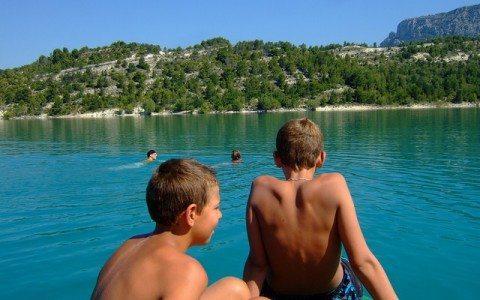Staying Safe at the Lake

Staying Safe at the Lake
There’s no doubt that lakes and other bodies of open water are a powerful attraction in good weather. While the water may look blue and inviting, calm, and relaxing, lakes can have hidden dangers that can send you to the emergency room at the end of the day.
Knowing the dangers is half the battle. Keeping friends, family, and yourself safe makes it fun for everyone.
Know Your Limits, Know Your Water
Lakes can change their characteristics depending on the time of year, making them unpredictable at any time. During spring and summer, for instance, the surface water may feel pleasantly warm when you dip your toe in, but the temperatures beneath the surface can be much lower. During autumn and winter, sudden weather changes can make calm lakes choppy and turn a casual swim into a marathon challenge to reach the shore, which can be further away than it looks.
Swimming in any open water is more strenuous than swimming in a pool. Unless you’re an experienced lake swimmer and know the water well, always wear a life jacket. Even the clearest lake water is actually quite murky when compared to pool water, so be aware of vegetation, obstacles such as tree limbs, rocks, broken glass or other submerged hazards. A sudden change in water depth is another hidden hazard that can take you by surprise. A life jacket can help keep you afloat if you’re suddenly out of your depth or if a strong current washes you off your feet.
Boating Safety
From small rowing boats to kayaks and motor vessels like jet skis, they’re all good fun on the water. Keep it that way by:
- Not overloading boats with too many people
- Not mixing alcohol with boating
- Making sure your life jacket fits properly
- Slowing down when passing other boats
- Heeding warning signs, buoys, sirens, or horns
- Knowing the boating and water safety laws in your area
- Staying away from dams
Jet skis can be a particular hazard, for those around them as well as those riding. Stay safe with these tips:
- Wear your life jacket
- Watch out for others in or around the water
- Wear a kill cord just in case you get thrown off
- Don’t take risks in other boat’s wakes
- Stay sober and keep your head
- Get to know your vehicle and how it responds
It’s all too easy to get caught up in the moment and lose your head, pushing just a bit faster or a bit further. Jet skiing is always exhilarating, as long as no one gets hurt.
Cuts and Bruises
Anywhere people gather there’s likely to be some litter left behind, much of which finds its way into lake waters. Cuts from sharp metal objects, broken glass, fishing hooks, or even natural dangers like fallen branches or sticks, are common in lakes. Wearing water shoes can help protect your feet, but they’re not foolproof.
Mostly, small cuts are easily treated at the site, so it’s wise to carry a first aid kit. Apply direct pressure to a cut with a clean cloth to stem any bleeding. Gently remove surface dirt and wash the area carefully, then dab it dry (don’t rub). If you have antiseptic cream or ointment, apply some then cover the wound. If your tetanus shot is out of date, you should take medical advice to find out if you need one.
You’ll need to visit the emergency room if:
- The bleeding won’t stop
- The wound is large or deep
- The victim develops a temperature or signs of infection appear
- There is any stiffness, swelling, or numbness in joints close to the site
Responding to Emergencies
In addition to taking along a first aid kit and making sure your cell phone is charged, there are other basic precautions everyone should take to stay safe around lakes. Parents should make sure children understand basic safety rules, and it doesn’t hurt to repeat them often. They include:
- Staying with their friends so they can help each other
- Not diving in unless an area is known to be safe
- Not jumping off trees or bridges
- Wading in slowly, feeling ahead to make sure the ground stays level (lakes can have sudden shelves and very deep water).
If someone does get into trouble, throw in anything that might help them float. If you can’t reach the person, use something to extend your access such as a pole, towel, or belt. If you’re wearing a life jacket, wade out to help. Don’t endanger yourself, however, or it just means there will be two people who need saving. If you aren’t sure of your ability call the emergency services instead, and let trained professionals help. Keeping yourself and your family safe means you’ll enjoy plenty more days out by the lake.




